Fisheries 2023, 7: 058
DOI: 10.24966/AAF-5523/100058

Fisheries 2023, 7: 058
DOI: 10.24966/AAF-5523/100058

Review Article
1South Dakota Department of Game, Fish, and Parks Cleghorn Springs State Fish Hatchery, 4725 Jackson Blvd. Rapid City, South Dakota 57703, USA
2South Dakota Department of Game, Fish, and Parks McNenny State Fish Hatchery 19619 Trout Loop Spearfish, South Dakota 57783, USA
Abstract
Recirculating Aquaculture Systems (RAS) technology is being implemented across the world. This paper describes the creation of a unique RAS system used initially for rearing hybrid sunfish [green sunfish (Lepomis cyanellus) x bluegill (Lepomis macrochirus)]. They system consisted of four, 2.44-m diameter tanks, radial flow separators, a bead filter, a heater/chiller, three pumps, three ultraviolet lamps, an oxygen generator, oxygen concentrator, and a custom-built degassing tower. Modifications during use included adoption of dual horizontal/vertical spraybars to facilitate tank hydraulic self-cleaning, elevated center tank drains to prevent plugging, additional oxygen generation, installation of outlet screens to prevent fish jumping, and elimination of electronic controls on the biofilter. The heater/chiller was unable to adjust water temperatures during the summer months and its use was discontinued during periods of high ambient temperatures. Initial use of the system was hampered by putting it into service too soon, prior to complete colonization of the biofilter. Addition of sodium bicarbonate at 20 to 25% of the daily ration, monitoring and adjusting water chemistry, and proper feed management were essential to maintain fish health and growth. Based on the results of this case study, temperatures above 23° C are recommended for hybrid sunfish, along with slow-sinking diets. Hybrid sunfish grew best on Optimal feeds.
*Corresponding author: Michael E Barnes, South Dakota Department of Game, Fish, and Parks McNenny State Fish Hatchery 19619 Trout Loop Spearfish, South Dakota 57783, USA, Tel: 1- 605-642-1262; Email: mike.barnes@state.sd.us
Citation: Treft CE, Fletcher B, Barnes ME (2023) Design and Construction of a Novel Recirculating Aquaculture System for the Initial Rearing of Hybrid Green Sunfish: A Case Study. J Aquac Fisheries 7: 58.
Received: April 06, 2023; Accepted: April 14, 2023; Published: April 21, 2023
Copyright: © 2023 Treft CE et. Al, This is an open-access article distributed under the terms of the Creative Commons Attribution License, which permits unrestricted use, distribution, and reproduction in any medium, provided the original author and source are credited.
Keywords: Aquaculture system; Circulation pumps; Hybrid green sunfish; Interior drain structure; Poly Vinyl Chloride; Tank setup
Recirculating Aquaculture Systems (RAS) continually re-use water for fish production, with the water treated by a series of processes [1]. RAS units generally include components to remove fish waste and other solids [2,3], biofilters to detoxify ammonia [4,5], strippers to remove carbon dioxide [6], devices to add oxygen [7], heaters/ chillers for temperature control [8], and ultraviolet radiation for microbial control [9,10].
Governmental fisheries management agencies have recently become more interested in using RAS to produce fish for recreational and conservation needs [11,12]. In early 2020, the natural resource agency for the state of South Dakota, USA (Department of Game, Fish and Parks) began designing and constructing its first RAS system, with the intent of producing catchable-sized (approximately 200 g) hybrid green sunfish (Lepomis cyanellus) x bluegill (Lepomis macrochirus) for stocking into recreational fishing waters in the spring of 2021. This paper describes the rapid development and employment of this system, along with initial observations on the rearing of hybrid green sunfish in RAS.
The RAS system consisted of the following:
1. Four, 2.44-m diameter circular fiberglass tanks with radial flow separators.
2. One bead filter (BubbleBead XS20000, Aquaculture Systems Technologies, LLC, Baton Rouge, Louisiana, USA).
3. One heater/chiller (Aquacal SQ166R, St. Petersburg, Florida, USA).
4. Two 0.75 hp water circulation pumps (Artesian2, Performance Pro Pumps, Hillsboro, Oregon, USA).
5. One pump for the heater/chiller loop (WLS150 sprinkler pump, Wayne Pumps, Harrison, Ohio, USA.
6. Three 150-watt high output ultraviolet lamps (Pentair, London, United Kingdom).
7. Oxygen generator (UFB 200, Gaia Water, Victoria, British Columbia, Canada).
8. Oxygen concentrator (Max 10, Pro O2, Birmingham, Alabama, USA).
9. 1.02 m3 degassing media (CF1200, L.S. Enterprises, Gainesville, Florida, USA).
Each, approximately 45-L, culture tank was a four-piece bolt together design comprised of two sides, a sump, and a Radial Flow Settler (RFS). The tanks were designed to use the Cornell Dual Drain System and had both a main cleaner water effluent and small concentrated waste stream [13]. The central tank sump was a recessed 61 cm x 61 cm square with a 5 cm hole in the middle for an exit (Figure 1). The sump drain exited the tank into the RFS on the side of the culture tank and was responsible for approximately 10-to-30% of the total tank effluent (Figure 2). The other 70-to-90% of the effluent exited the culture tank via the side drain, bypassing the RFS. The RFS captured and contained a large amount of the settleable solids in the system (Figures 3 & 4).

Initially, water was directed into each tank with single vertical spray bar constructed of 5 cm Poly Vinyl Chloride (PVC) pipe submerged approximately 46 cm beneath the water surface. Despite providing adequate tank spin, tank self-cleaning properties proved to be lackluster with little draw exiting the central drain. The spraybar was subsequently redesigned and refabricated to include both a vertical and horizontal section [14,15] (Figure 5). Both sections were connected by a threaded tee, allowing each to be individually adjusted. Replacing vertical spraybars with this two-piece design provided much more control of in-tank water velocities and greatly enhanced the self-cleaning properties of the circular tanks [16,17]. Just as with the spraybar changes from the initial design, the central tank drain screen was also modified after its initial use. For the first 70 days, simple aluminum screens with 0.635 cm holes were used to cover the tank sumps, similar to a typical single-pass culture tank [18]. However, as feeding rates increased, the metal screens created quiescent zones in the tank sumps, interfering with waste movement to the RFS units. To solve this problem, the metal screens were removed and replaced with 5 cm PVC drainpipes [16] (Figure 6). Each new drainpipe was press-fit into a 90-degree PVC elbow that was molded into each tank sump. By removing the metal screen, waste had an unobstructed path to the central drain, and by modifying the inlet/outlet structures daily cleaning was dramatically reduced.
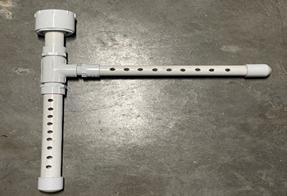

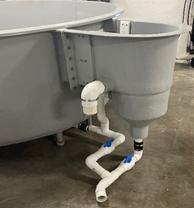




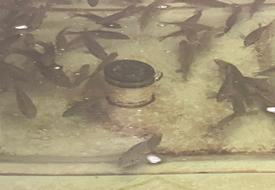
To remove carbon dioxide, a stripping device based on a cascade design where large air volumes contact process water was used [6]. Initial calculations indicated that at approximately 0.028 m3 of bio-media would be required to maintain appropriate carbon dioxide levels at maximum carrying capacity and feeding rates of one percent bodyweight per day [19,20] (Figure 7). In addition to degassing, the media also acted as trickling bioreactor. Aluminum framing and 1.2 x 2.4 m sheets of black HDPE panels were used to construct the counter-flow packed tower [21]. The tower was large enough to accommodate four layers of bio-media, each 91.4 cm x 91.4 cm x 30.5 cm, and was semi-modular to accommodate possible future expansion (Figure 8). The top of the tower had a manifold leading to four spray nozzles that evenly distributed the water across the media (Figure 9). The skirt on the bottom of the structure was submerged in a 1,250 L Intermediate Bulk Container (IBC) tote that served as a collection basin for the water that was pumped through the tower. a 6.4 m3/min CFM blower distributed the air underneath the media for maximum gas transfer (Figure 10). The exhausted air was vented out the top of the tower, with a connection to an existing sewer vent for expulsion from the building.


The nano bubbler with the capacity of 18 kg of oxygen per day at approximately 85 percent efficiency, was incorporated into the main system pump line to deliver oxygen to the system [22] (Figure 11). This eliminated the need for a side loop and additional pumps. While this component was reliable, there were concerns that the head pressure required would affect tank hydraulic retention times. This problem can be mitigated by incorporating the nano bubbler on the pump of another water treatment process or upsizing to a larger unit. Upon reflection, using the larger UFB 300 may have been a better choice because it would have likely dramatically-reduced head pressure. To provide up to an additional 10 L/min of oxygen at approximately 95% purity, the oxygen concentrator was also used (Figure 12).

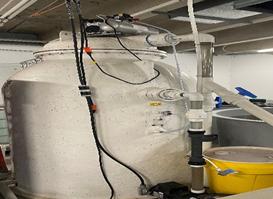

A bead filter was used as the primary biofiltration [23,24] (Figure 14). It contained approximately 0.28 m3 of media and acted as both a biofilter and solids filter [25]. At feed rations of 5 kg/day, ammonia levels remained within acceptable limits [8]. Bead filter backwash frequency was primarily determined by efficacy of radial flow settlers, total feed ration, and prudent feeding practices [24,26,27]. The integrated automatic timer to independently initiate bead filter backwashes failed several months into service, which required manual backwashes there-after. The bead filter was eventually replaced with the T Polygeyser HPPG 25 (Aquaculture Systems Technologies, LLC, Baton Rouge, Louisiana, USA) which operates solely with air; no electronics are used (Figure 15). Three 150-watt ultraviolet sterilizers were used for disinfection [28,29] (Figure 16).
For temperature control [8], water was pumped on a side loop from the carbon dioxide tower collection tank to the chiller/heater and returned to the collection tank (Figure 13). Air flow exchange problems were encountered during the summer months, when the unit exhausted heat into an already hot room. To prevent excessive operation of the unit, water temperatures were allowed to rise above optimal levels during the summer. Design considerations moving forward are to construct a fume hood over each unit to exhaust at least 99 m3/min of air. Aside from the peak summer months, the chiller/heater worked well.
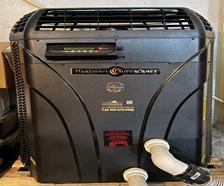
Citation: Treft CE, Fletcher B, Barnes ME (2023) Design and Construction of a Novel Recirculating Aquaculture System for the Initial Rearing of Hybrid Green Sunfish: A Case Study.
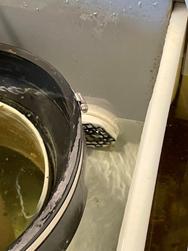

There-after, at approximately two-week intervals, feeding rates were set at 90% of the amount consumed (apparent satiation) at 15 minutes.
1. Do not rush the system! Supply chain issues caused system construction to require more time than anticipated. As a result of the delay, this initial RAS unit was only allowed to run for two days before the insertion of fish into the system. This timing did not allow the biofilter to be fully-functioning. At rearing day 28, ammonia spiked to unreadable levels [30-32] and caused catastrophic mortality. If the biofilter had been allowed the time to be fully-functioning, and if a water quality testing routine had been established, this mortality would likely not have occurred.
Two pumps were used to move the water. The first pump moved the water through the BubbleBead filter, the UV lamps, and up to the top of the carbon dioxide degassing tower. The second pump moved the eater from the degassing tower through the nano bubbler to a head tank. A master valve after the second pump allowed for synchronization between the two pumps. While it worked effectively, this twopump system was temperamental and difficult to balance. A schematic of the entire RAS system is show in (Figure 17).

2. Add sodium bicarbonate at 20-to-25% of daily feed ration. No sodium bicarbonate was added to the system, with total alkalinity only 5 mg/L when the 28-day mortality event occurred. Alkalinity is extremely important for nitrifying bacteria, with low levels resulting in biofilter malfunction [33,34]. Because of the premature start of rearing in the system, practically all alkalinity had been consumed by bacteria [34,35].
3. Fish do not always stay in tanks. While the tops of the tanks were partially-covered, fish still jumped from tanks [36]. In some cases, these escapee fish blocked return lines, caused every tank to overflow, and led to minor mortality. Placing a screen over every side drain outlet eliminated this problem (Figure 18).
Two days after construction of the system, approximately 11,000 hybrid green sunfish (ranging from 0.83 to 4.1 grams) were placed in the tanks. Feed was withheld for seven days to acclimate the fish and to allow for at least some bacterial growth in the biofilter. On the eighth day, the fish were fed at a rate of 100 grams/tank for the next 13 days. At day 21, feed was increased to 0.4 kg/tank for the next 7 days.
4. Know water quality parameters and test for the proper ranges. During the ammonia spike, a water quality testing routine had not been established. In addition, reagent kits for “optimal water parameter readings” were the only kits on site. When the situation reached acute severity, accurate information could not be obtained because the ranges were too high to register on the spectrophotometer.
5. Proper feed management is key to system health. Initially, the fish were grossly overfed. This led to constant system imbalances, as well as inconsistent and unpredictable cleaning cycles. Using an adaptive feeding strategy based on near-satiation was extremely important, reducing daily tank cleaning to zero. In addition, BubbleBead filter flushing was reduced to only 2-to-3 times per week.
Citation: Treft CE, Fletcher B, Barnes ME (2023) Design and Construction of a Novel Recirculating Aquaculture System for the Initial Rearing of Hybrid Green Sunfish: A Case Study. J Aquac Fisheries 7: 58.
Temperature - The sunfish appear to feed quite well at any temperature above 23° C, with smaller fish feeding voraciously at even lower temperatures. As fish grew, it became necessary to increase temperature to 27° C to maintain an acceptable feeding response [37].
Density - The maximum density reached in a culture tank was approximately 30 kg/m3, although higher densities can likely be achieved.
Diets Used and Feeding Behavior- A variety of feeds were used during this initial rearing trial, with the nutrient profile of the Optimal Fish Food Junior floating diet most closely matching the requirements for sunfish [38]. These diets and the response of the sunfish is described in (Table 1). The sunfish much prefer a slow sinking diet compared to a floating diet. Larger fish appeared to feed aggressively on the floating diet for a short period of time, but then slowly lose interest throughout the day.
CleanAssist Skrettinga Aggressive feeding behavior
Classic Trout Skretting Not eaten, rapid pellet disintegration
Europa Skretting Mixed feeding behavior, fish rejected sizes > 3.0 mm
Starter Optimalb Readily accepted up to 3.0 mm
Junior Optimal Very aggressive feeding
EP2 Otohimec Feeding after it sinks
Table 1: Diets used, feed manufacturers, and feeding observations of hybrid green sunfish in an initial recirculating aquaculture system.
aSkretting = Tooele, Utah, USA
bOptimal = Omaha, Nebraska, USA
cOtohime = Pacific Trading Company, Fukuoka, Japan
This initial attempt of rearing hybrid green sunfish in a uniquely designed and quickly fabricated RAS system was moderately successful. Fish were reared to the desired size. Most importantly, the lessons learned from this initial effort will lead to changes in subsequent system design and rearing procedures. Abundant further research and development opportunities exist.
We thank Alex Rosburg and Shaylee Martling for their assistance with this project.
1. Espinal CA, Matulić D (2019) Recirculating Aquaculture Technologies. In: Goddek S, Joyce A, Kotzen B, Burnell GM (eds) Aquaponics Food Production Systems. Springer Cham 35-76
2. Chen S, Coffin DE, Malone RF (1994) Suspended solids control in recirculating aquaculture systems. In: Timmons MB, Losordo TM (eds) Aquaculture water reuse systems: Engineering design and management. Elsevier Amsterdam 61-100
3. Couturier M, Trofimencoff T, Buil JU, Conroy J (2009) Solids removal at a recirculating salmon-smolt farm. Aquac Eng 41: 71-77
4. Gutierrez-Wing MT, Malone RF (2006) Biological filters in aquaculture: trends and research directions for freshwater and marine applications. Aquac Eng 34: 163-171
5. Summerfelt ST (2006) Design and management of conventional fluidized-sand biofilters. Aquac Eng 34: 275-302
6. Moran D (2010) Carbon dioxide degassing in fresh and saline water. I: degassing performance of a cascade column. Aquac Eng 43: 29-36
7. Colt JE, Watten BJ (1988) Applications of pure oxygen in fish culture. Aquac Eng 7: 397441
8. Saidu MM, Hall SG, Kolar P, Schramm R, Davis T (2012) Efficient temperature control in recirculating aquaculture tanks. Applied Eng Agric 28: 161-167
9. Sharrer MJ, Summerfelt ST, Bullock GL, Gleason LE, Taeuber J (2005) Inactivation of bacteria using ultraviolet irradiation in a recirculating salmonid culture system. Aquac Eng 33: 135-149
10. Summerfelt ST, Sharrer MJ, Tsukuda SM, Gearheart M (2009) Process requirements for achieving full-flow disinfection of recirculating water using ozonation and UV irradiation. Aquac Eng 40: 17-27
11. Aneshansley ED, Timmons MD, Colesante RI (2001) Survival and growth of walleye Stizostedion vitreum fry as affected by water recirculation, feed transition age, and stocking density. J World Aquac Soc 32: 89-95
12. Meerbeek JR (2021) Short-term survival of yearly Muskellunge raised in a recirculating aquaculture system. Study 7060 Completion Report. Iowa Department of Natural Resources, Ames, Iowa.
13. Summerfelt ST, Davidson JW, Waldrop TB, Tsukuda SM, Bebak-Williams J (2004) A partial reuse system for coldwater aquaculture. Aquac Eng 31: 157-181
14. Skybakmoen S (1989) Impact of water hydraulics on water quality in fish rearing units. Aqua Nor 89, Conference 3-Water Treatment and Quality 17.
15. Tvinnereim K, Skybakmoen S (1989) Water exchange and self-cleaning in fish-rearing tanks. In: De Pauw, N. et al. (Ed) Aquaculture: A biotechnology in progress: volume 2. European Aquaculture Society: Bredene 1041-1047.
16. Timmons MB, Summerfelt ST, Vinci BJ (1998) Review of circular tank technology and management. Aquac Eng 18: 51-69
17. Oca J, Masalo I (2013) Flow pattern in aquaculture circular tanks: Influence of flow rate, water depth, and water inlet & outlet features. Aquac Eng 52: 65-72
18. Pipe, RG, McElwain IB, Orme LE, McCraren JP, Fowler LG, et al. (1982) Fish Hatchery Management. U.S. Fish and Wildlife Service, Washington DC.
19. Datta, S (2012) Management of water quality in intensive aquaculture. Respiration 6: 602
20. Neethu KC, Balasubramanian CP, Biju IF, Rekha MU, Suvana S, et al. (2020) Recirculating aquaculture system: Concepts and designs. Aquac Spectrum 3: 33-37
21. Hackney GE, Colt JE (1982) The performance and design of packed column aeration systems for aquaculture. Aquac Eng 1: 275-295
22. Suhr KI, Pedersen PB, Arvin E (2013) End-of-pipe denitrification using RAS effluent waste streams: Effect of C/N-ratio and hydraulic retention time. Aquac Eng 53: 57-64
23. Malone RF, Beecher LE, DeLosReyes AA (1998) Sizing and management of floating bead bioclarifiers. Proceedings of the Second International Conference on Recirculating Aquaculture 16-19.
24. Sastry BN, DeLosReyes AA, Rusch KA, Malone RF (1999) Nitrification performance of a bubble-washed bead filter for combined solids removal and biological filtration in a recirculating aquaculture system. Aquac Eng 19: 105-117
Citation: Treft CE, Fletcher B, Barnes ME (2023) Design and Construction of a Novel Recirculating Aquaculture System for the Initial Rearing of Hybrid Green Sunfish: A Case Study. J Aquac Fisheries 7: 58.
25. Cripps SJ, Bergheim A (2000) Solids management and removal for intensive land-based aquaculture production systems. Aquac Eng 22: 33-56
26. Wimberly DM (1990) Development and evaluation of a low-density media biofiltration unit for use in recirculating finfish culture systems. PhD dissertation, Louisiana State University, Baton Rouge.
27. Golz W, Rusch KA, Malone RF (2002) Developing backwash protocols for floating bead filters: A model of solids-loading and biofilm-retention effects on nitrification. AES Technical Session 1: Open Papers.
28. Joyce EM, Mason TJ, Lorimer JP (2006) Application of UV radiation or electrochemistry in conjunction with power ultrasound for the disinfection of water. Int J Environ Pollution 27: 222-230
29. Schoina E, Doulgeraki AI, Miliou H, Nychas GJE (2022) Dynamics of water and biofilm bacterial community composition in a Mediterranean recirculation aquaculture system. Aquac J 2: 164-179
30. Summerfelt RC, Lewis WM (1967) Repulsion of green sunfish by certain chemicals. J Water Pollution Control Federation 1: 2030-2038
31. McCormick JH, Broderius SJ, Fiandt JT (1984) Toxicity of ammonia to early life stages of the green sunfish Lepomis cyanellus. Environmental Pollution Series A Ecological and Biological 36: 147-63
32. Randall DJ, Tsui TKN (2002) Ammonia toxicity in fish. Marine Poll Bull 45: 17-23.
33. Colt J (2006) Water quality requirements for reuse systems. Aquac Eng 34: 143-156
34. Summerfelt ST, Zulke A, Kolarevic J, Megard Reiten BK, Selset R, et al. (2015) The effects of alkalinity on ammonia removal, carbon dioxide stripping, and pH in semi-commercial scale water recirculating aquaculture systems operated with moving bed bioreactors. Aquac Eng 65: 46-54
35. Hamidi HP, Kenari SL, Basu OD (2020) Simultaneous TOC and ammonia removal in drinking-water biofilters: Influence of pH and alkalinity. J Environ Eng 146: 04020080
36. Tuckett QM, Martinez CV, Ritch JL, Lawson KM, Hill JE (2016) Preventing Escape of Non-Native Species from Aquaculture Facilities in Florida, Part 3: Structural Strategies: FA197, EDIS 7: 9
37. Wang N, Hayward RS, Noltie DB (1998) Effect of feeding frequency on food consumption, growth, size variation, and feeding pattern of age-0 hybrid sunfish. Aquac 165: 261-267
38. Yang M, Wang J, Han T, Yunxia Y, Xinyu L, et al. (2016) Dietary protein requirement of juvenile bluegill sunfish (Lepomis macrochirus). Aquac 459: 191-197
Advances In Industrial Biotechnology | ISSN: 2639-5665
Advances In Microbiology Research | ISSN: 2689-694X
Archives Of Surgery And Surgical Education | ISSN: 2689-3126
Archives Of Urology
Archives Of Zoological Studies | ISSN: 2640-7779
Current Trends Medical And Biological Engineering
International Journal Of Case Reports And Therapeutic Studies | ISSN: 2689-310X
Journal Of Addiction & Addictive Disorders | ISSN: 2578-7276
Journal Of Agronomy & Agricultural Science | ISSN: 2689-8292
Journal Of AIDS Clinical Research & STDs | ISSN: 2572-7370
Journal Of Alcoholism Drug Abuse & Substance Dependence | ISSN: 2572-9594
Journal Of Allergy Disorders & Therapy | ISSN: 2470-749X
Journal Of Alternative Complementary & Integrative Medicine | ISSN: 2470-7562
Journal Of Alzheimers & Neurodegenerative Diseases | ISSN: 2572-9608
Journal Of Anesthesia & Clinical Care | ISSN: 2378-8879
Journal Of Angiology & Vascular Surgery | ISSN: 2572-7397
Journal Of Animal Research & Veterinary Science | ISSN: 2639-3751
Journal Of Aquaculture & Fisheries | ISSN: 2576-5523
Journal Of Atmospheric & Earth Sciences | ISSN: 2689-8780
Journal Of Biotech Research & Biochemistry
Journal Of Brain & Neuroscience Research
Journal Of Cancer Biology & Treatment | ISSN: 2470-7546
Journal Of Cardiology Study & Research | ISSN: 2640-768X
Journal Of Cell Biology & Cell Metabolism | ISSN: 2381-1943
Journal Of Clinical Dermatology & Therapy | ISSN: 2378-8771
Journal Of Clinical Immunology & Immunotherapy | ISSN: 2378-8844
Journal Of Clinical Studies & Medical Case Reports | ISSN: 2378-8801
Journal Of Community Medicine & Public Health Care | ISSN: 2381-1978
Journal Of Cytology & Tissue Biology | ISSN: 2378-9107
Journal Of Dairy Research & Technology | ISSN: 2688-9315
Journal Of Dentistry Oral Health & Cosmesis | ISSN: 2473-6783
Journal Of Diabetes & Metabolic Disorders | ISSN: 2381-201X
Journal Of Emergency Medicine Trauma & Surgical Care | ISSN: 2378-8798
Journal Of Environmental Science Current Research | ISSN: 2643-5020
Journal Of Food Science & Nutrition | ISSN: 2470-1076
Journal Of Forensic Legal & Investigative Sciences | ISSN: 2473-733X
Journal Of Gastroenterology & Hepatology Research | ISSN: 2574-2566
Journal Of Genetics & Genomic Sciences | ISSN: 2574-2485
Journal Of Gerontology & Geriatric Medicine | ISSN: 2381-8662
Journal Of Hematology Blood Transfusion & Disorders | ISSN: 2572-2999
Journal Of Hospice & Palliative Medical Care

Journal Of Human Endocrinology | ISSN: 2572-9640
Journal Of Infectious & Non Infectious Diseases | ISSN: 2381-8654
Journal Of Internal Medicine & Primary Healthcare | ISSN: 2574-2493
Journal Of Light & Laser Current Trends
Journal Of Medicine Study & Research | ISSN: 2639-5657
Journal Of Modern Chemical Sciences
Journal Of Nanotechnology Nanomedicine & Nanobiotechnology | ISSN: 2381-2044
Journal Of Neonatology & Clinical Pediatrics | ISSN: 2378-878X
Journal Of Nephrology & Renal Therapy | ISSN: 2473-7313
Journal Of Non Invasive Vascular Investigation | ISSN: 2572-7400
Journal Of Nuclear Medicine Radiology & Radiation Therapy | ISSN: 2572-7419
Journal Of Obesity & Weight Loss | ISSN: 2473-7372
Journal Of Ophthalmology & Clinical Research | ISSN: 2378-8887
Journal Of Orthopedic Research & Physiotherapy | ISSN: 2381-2052
Journal Of Otolaryngology Head & Neck Surgery | ISSN: 2573-010X
Journal Of Pathology Clinical & Medical Research
Journal Of Pharmacology Pharmaceutics & Pharmacovigilance | ISSN: 2639-5649
Journal Of Physical Medicine Rehabilitation & Disabilities | ISSN: 2381-8670
Journal Of Plant Science Current Research | ISSN: 2639-3743
Journal Of Practical & Professional Nursing | ISSN: 2639-5681
Journal Of Protein Research & Bioinformatics
Journal Of Psychiatry Depression & Anxiety | ISSN: 2573-0150
Journal Of Pulmonary Medicine & Respiratory Research | ISSN: 2573-0177
Journal Of Reproductive Medicine Gynaecology & Obstetrics | ISSN: 2574-2574
Journal Of Stem Cells Research Development & Therapy | ISSN: 2381-2060
Journal Of Surgery Current Trends & Innovations | ISSN: 2578-7284
Journal Of Toxicology Current Research | ISSN: 2639-3735
Journal Of Translational Science And Research
Journal Of Vaccines Research & Vaccination | ISSN: 2573-0193
Journal Of Virology & Antivirals
Sports Medicine And Injury Care Journal | ISSN: 2689-8829
Trends In Anatomy & Physiology | ISSN: 2640-7752